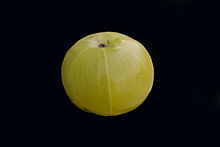Indian gooseberry
| Phyllanthus emblica | |
|---|---|
 |
|
| Plant | |
 |
|
| Fruit | |
| Scientific classification | |
| Kingdom: | Plantae |
| (unranked): | Angiosperms |
| (unranked): | Eudicots |
| (unranked): | Rosids |
| Order: | Malpighiales |
| Family: | Phyllanthaceae |
| Tribe: | Phyllantheae |
| Subtribe: | Flueggeinae |
| Genus: | Phyllanthus |
| Species: | P. emblica |
| Binomial name | |
|
Phyllanthus emblica L. |
|
| Synonyms | |
|
|
Phyllanthus emblica, also known as emblic,emblic myrobalan,myrobalan,Indian gooseberry,Malacca tree, or amla from Sanskrit amalika is a deciduous tree of the family Phyllanthaceae. It is known for its edible fruit of the same name.
The tree is small to medium in size, reaching 1–8 m (3 ft 3 in–26 ft 3 in) in height. The branchlets aren't glabrous or finely pubescent, 10–20 cm (3.9–7.9 in) long, usually deciduous; the leaves are simple, subsessile and closely set along branchlets, light green, resembling pinnate leaves. The flowers are greenish-yellow. The fruit is nearly spherical, light greenish yellow, quite smooth and hard on appearance, with six vertical stripes or furrows.
Ripening in autumn, the berries are harvested by hand after climbing to upper branches bearing the fruits. The taste of Indian emblic is sour, bitter and astringent, and it is quite fibrous. In India, it is common to eat emblic steeped in salt water and red chilli powder to make the sour fruits palatable.
The tree is considered sacred by Hindus as God Vishnu is believed to dwell in it. The tree is worshiped on Amalaka Ekadashi.
In other Hindu beliefs, Amla is said to have originated from the drops of Amrit which spilled on earth accidentally, because of the fight of Gods and Demons after ksheera sagar manthan. And hence also this religious belief makes claims that it almost cures every disease and is also good in extending the longevity of life.
In the Sanskrit Buddhist tradition half an amalaka fruit was the final gift to the Buddhist sangha by the great Indian emperor Ashoka. This is illustrated in the Ashokavadana in the following verses:
"A great donor, the lord of men, the eminent Maurya Ashoka, has gone from being lord of Jambudvipa [the continent] to being lord of half a myrobalan." (Strong, 1983, p. 99) This deed became so famous that a stupa was created to mark the place of the event in modern-day Patna and was known as the Amalaka stupa.
According to Hindu tradition, Adi Shankara of Kerala composed and recited the Kanakadhara stotram in praise of Mahalakshmi to make a poor Brahmin lady get wealth, in return for a single amla presented to him as bhiksha on an auspicious dwadashi day. Contemporary poet/philosopher Ravi Teja Yelamanchili wrote a book titled Amalaki. The book is based on Advaita Vedanta of Sri Adi Shankaracharya.
...
Wikipedia
